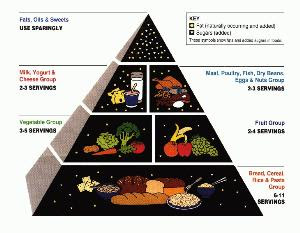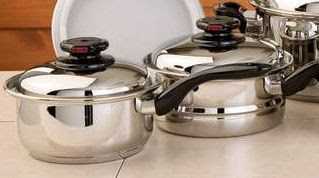 If you have been considering the purchase of stainless steel cookware, you may have encountered ads featuring waterless cookware. For many, the world of “waterless cooking” is an unknown entity. As a user and vendor of waterless stainless steel cookware, I would like to address several of the most frequently asked questions regarding waterless cookware.
If you have been considering the purchase of stainless steel cookware, you may have encountered ads featuring waterless cookware. For many, the world of “waterless cooking” is an unknown entity. As a user and vendor of waterless stainless steel cookware, I would like to address several of the most frequently asked questions regarding waterless cookware.What is Waterless Cooking?
Waterless cooking has gotten a lot of publicity in recent months. Is it just hype? Actually, no! Waterless cooking really has been around for quite some time. Waterless cooking, unlike conventional cooking, uses minimal or no water. It relies instead on the natural moisture in the food. As a result, very few nutrients are lost in the cooking process. Lower cooking temperatures and steam-controlled cookware retains the natural juices of the food, enhancing their taste. When cooking vegetables, for example, simply rinsing the vegetables in water and shaking off the excess water provides enough moisture to cook the vegetables to the desired state of doneness. Obviously, dried foods, like beans, rice, pasta, etc, require more liquid to cook properly.
What is multi-ply?
Ply refers to the number of layers in the bottom of the encapsulated pan. Some refer to it as element. These layers are important because the number of ply or elements allows for even heat flow and durability. The aluminum conducts the heat well in the inner layers. However, it is not desirable on the outside because it corrodes and comes off on the food. The multi-layers include stainless steel on the entire outside (top and bottom) of the encapsulated bottom. The inner layers consist of aluminum, as well as other metals, that are considered to be better conductors of heat. These multi-layers spread the heat evenly, insuring that there are no "hot spots." The thickness of the cookware also reduces chances of the piece warping. Stainless steel protects the food and the cookware itself.
Recently there has been an increase in the number of layers or ply added to the cookware. For cookware to be classified as waterless, it must be at least 5-ply or have five layers. Our company features cookware that has 7-ply, 9-ply and even 12-ply construction. While extra ply will very minimally increase the weight of the pan, it does not mean that your food will cook any better or taste any different because of the extra layers. When considering the purchase of cookware, use factors other than multi-ply (such as number and type of pieces in the cookware set) to determine which set is the best choice for you.
What Is Waterless Cookware?
While all waterless stainless steel cookware is made out of quality stainless steel, not all stainless steel cookware is quality or waterless. To be classified as waterless, the cookware must meet 4 requirements.
- A high-grade stainless steel must be used. Waterless cookware must be a minimum of 5-ply. You will often see advertisements for products with 7-ply or 9-ply or possibly more. To some degree, the layering is important. Stainless steel is a great material for waterless cooking, but stainless steel is not known for fast heat transfer. Thus, the addition of a layer of aluminum in the center of the stainless steel provides for the fast and even distribution of heat.
- A Flat-bottomed pan is needed for efficient heat transfer. The bottom of a waterless cooking pan needs to be flat to provide for even heat distribution.
- A thicker bottom plate is necessary to evenly distribute the heat. The special design of the encapsulated bottom of each stainless steel pot provides strength and rigidity that prevents warping. It also eliminates hot spots that may burn food. Heat is distributed evenly in all directions.
- A special lid is used to keep the steam from escaping. Waterless cooking will not work if a proper seal cannot be formed. When a seal is created, it locks in the natural moisture that escapes from the food during the cooking process. Thus, foods are cooked in their own natural juices, retaining vital vitamins and minerals. This is really the key to waterless cooking—a vapor seal must be created.
While I cannot speak for other brands, I can tell you that our Maxam Stainless Steel Cookware meets the criteria above. Maxam Cookware has over 50 years of experience and research going into the production of its products. Further, this quality cookware can be purchased for a fraction of the cost of comparable quality cookware offered at the State Fair.
Why is your stainless steel product cheaper than some of the other waterless cookware brands?
There is virtually little difference between all of the quality cookware brands. One of the unique features of our brand is the steam-control valve on most of our sets. This valve on most of our lids helps you determine exactly when to turn the temperature down. Some of the other brands do not have this steam release valve. Generally, if a waterless cookware set is constructed of a high-grade stainless steel, such as 304 surgical stainless steel (used in all waterless cookware), the manufacturing company has a good reputation (Maxam has been around since the 1950s), there is a Factory Lifetime Warranty that includes a customer service address with every set, then you can be quite certain that you are receiving a quality, high grade set of cookware. We are not experts on other brands so it would be unfair of us to compare their product to ours. Some of these other cookware brands cost between $1000 and $2000 more. That difference in price between our product and theirs is not because of quality differences. More likely it is because of difference in marketing. With our product, you are dealing with the wholesale market rather than the retail market. Many of the higher priced brands are shown at home shows, county and state fairs, etc. and require a much greater marketing budget than our form of sales.
We hope you found this information helpful. If you decide that you would like to investigate stainless steel cookware further, visit our site – The Gourmet’s Cookware. Not only do we provide additional information about waterless cooking, we have also included some great waterless cooking recipes.
Marcia Klun is the owner and webmaster of www.thegourmetscookware.com, a site that offers quality stainless steel products, such as waterless cookware sets, stockpots, cutlery, skillets, flatware, and other gourmet cooking essentials. In addition, the site offers relevant information about waterless cooking and provides a variety of healthy recipes that can be adapted to waterless cookware.

























 9-element construction allows you to stack cook. You can begin by cooking on individual burners. Then you can stack the pans to finish cooking—an energy savings!
9-element construction allows you to stack cook. You can begin by cooking on individual burners. Then you can stack the pans to finish cooking—an energy savings!



